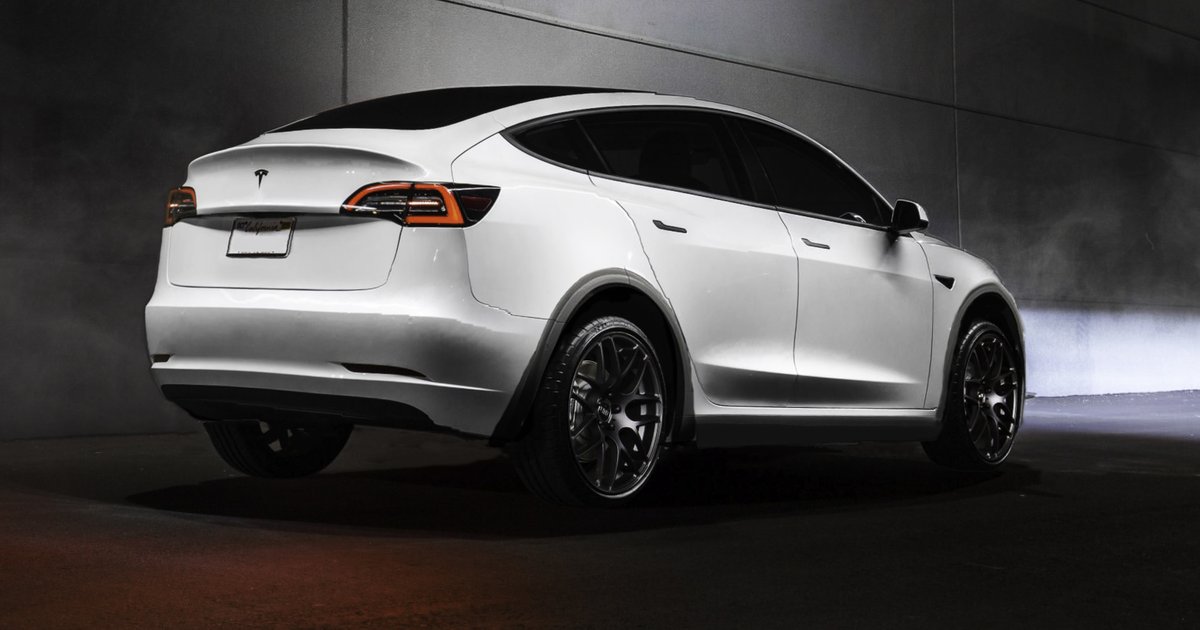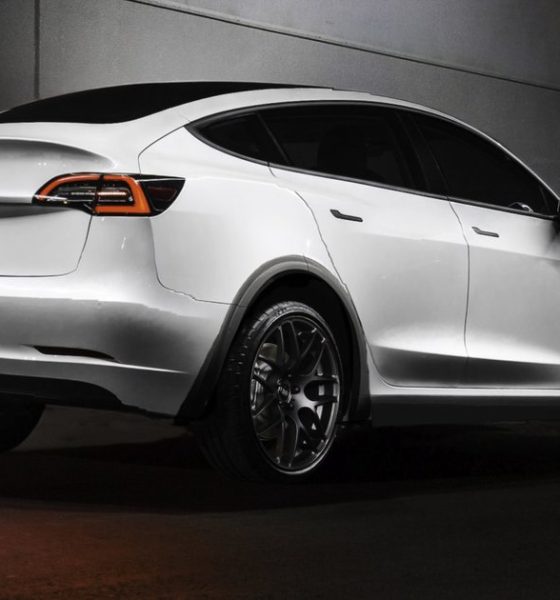

News
Tesla Model Y will awaken Elon Musk’s ‘Alien Dreadnaught’ factory
Elon Musk’s “Alien Dreadnought” factory could see a second coming when Tesla Model Y is ready for production ramp, thanks to recent advancements in computer vision.
Before Tesla started the Model 3 ramp, Elon Musk described his vision for a hyper-automated factory that he described as “the machine that builds the machine.” Addressing investors, Musk revealed that the project’s code name was the “Alien Dreadnought,” a reference to the futuristic spacecraft usually utilized by extraterrestrials in sci-fi movies. Musk planned to use the Alien Dreadnought for the Model 3 ramp, and he expected the automated factory to be operational by 2018.
This timeline proved to be too optimistic, with the Tesla CEO later admitting that he had been far too enthusiastic with the Model 3 production line’s automation. “Humans are underrated,” Musk admitted in an interview with CBS. Ultimately, it was a combination of traditional human work and non-Alien-Dreadnought type of automation that became a breakthrough for the Model 3 ramp. Tesla has since gotten the hang of Model 3 production, with the company producing enough vehicles for the US, as well as Europe and China (at least for selected regions) today.

According to Ryan Kottenstette, who serves as the CEO of Cape Analytics, a group that conducts computer vision research, the challenges Tesla faced with the Model 3 ramp were caused by the limitations of robotic vision. Kottenstette notes that the robots Tesla utilized in the Model 3 line simply could not deal with unexpected events in the production process, such as different orientations of nuts and bolts, or complicated maneuvering between the car frame.
Musk mentioned one of these challenges in the Q1 2018 earnings call when he described a machine he fondly called “Flufferbot,” which had a lot of difficulties scooping out fiberglass mats (or “fluff” as Musk described it) for the Model 3 battery pack. Musk stated that Flufferbot eventually lost its job because it became evident that scooping out “fluff” is far easier when done with human hands.

Kottenstette argues that computer vision has progressed significantly in recent years, with approaches such as GANs (Generative Adversarial Networks) and unsupervised learning expanding the envelope of computer vision in terms of applications, robustness, and reliability. These advancements can help address some of the challenges faced by Tesla during the days of the Model 3 ramp. Coupled with Tesla’s proficiency in tech, and augmented by the company’s robust AI team, these new computer vision approaches can be leveraged to allow another attempt at Elon Musk’s “Alien Dreadnought” factory.
An opportunity is actually preseting itself for Tesla, as the company is scheduled to unveil the Model Y SUV next week. Just like the Model 3, the Model Y is a high-volume, mass-market vehicle, with Elon Musk expecting demand for the vehicle to go as high as 1 million units per year. Unlike the Model S, X, and Model 3, Tesla is set to start the initial production of the Model Y at Gigafactory 1 in Nevada, which means that the company can design and set up the SUV’s production lines from a blank slate. Thanks to the Model Y, Elon Musk’s “Alien Dreadnought” factory might end up being closer than we think.

Elon Musk
Tesla’s Elon Musk: 10 billion miles needed for safe Unsupervised FSD
As per the CEO, roughly 10 billion miles of training data are required due to reality’s “super long tail of complexity.”

Tesla CEO Elon Musk has provided an updated estimate for the training data needed to achieve truly safe unsupervised Full Self-Driving (FSD).
As per the CEO, roughly 10 billion miles of training data are required due to reality’s “super long tail of complexity.”
10 billion miles of training data
Musk comment came as a reply to Apple and Rivian alum Paul Beisel, who posted an analysis on X about the gap between tech demonstrations and real-world products. In his post, Beisel highlighted Tesla’s data-driven lead in autonomy, and he also argued that it would not be easy for rivals to become a legitimate competitor to FSD quickly.
“The notion that someone can ‘catch up’ to this problem primarily through simulation and limited on-road exposure strikes me as deeply naive. This is not a demo problem. It is a scale, data, and iteration problem— and Tesla is already far, far down that road while others are just getting started,” Beisel wrote.
Musk responded to Beisel’s post, stating that “Roughly 10 billion miles of training data is needed to achieve safe unsupervised self-driving. Reality has a super long tail of complexity.” This is quite interesting considering that in his Master Plan Part Deux, Elon Musk estimated that worldwide regulatory approval for autonomous driving would require around 6 billion miles.
FSD’s total training miles
As 2025 came to a close, Tesla community members observed that FSD was already nearing 7 billion miles driven, with over 2.5 billion miles being from inner city roads. The 7-billion-mile mark was passed just a few days later. This suggests that Tesla is likely the company today with the most training data for its autonomous driving program.
The difficulties of achieving autonomy were referenced by Elon Musk recently, when he commented on Nvidia’s Alpamayo program. As per Musk, “they will find that it’s easy to get to 99% and then super hard to solve the long tail of the distribution.” These sentiments were echoed by Tesla VP for AI software Ashok Elluswamy, who also noted on X that “the long tail is sooo long, that most people can’t grasp it.”
News
Tesla earns top honors at MotorTrend’s SDV Innovator Awards
MotorTrend’s SDV Awards were presented during CES 2026 in Las Vegas.

Tesla emerged as one of the most recognized automakers at MotorTrend’s 2026 Software-Defined Vehicle (SDV) Innovator Awards.
As could be seen in a press release from the publication, two key Tesla employees were honored for their work on AI, autonomy, and vehicle software. MotorTrend’s SDV Awards were presented during CES 2026 in Las Vegas.
Tesla leaders and engineers recognized
The fourth annual SDV Innovator Awards celebrate pioneers and experts who are pushing the automotive industry deeper into software-driven development. Among the most notable honorees for this year was Ashok Elluswamy, Tesla’s Vice President of AI Software, who received a Pioneer Award for his role in advancing artificial intelligence and autonomy across the company’s vehicle lineup.
Tesla also secured recognition in the Expert category, with Lawson Fulton, a staff Autopilot machine learning engineer, honored for his contributions to Tesla’s driver-assistance and autonomous systems.
Tesla’s software-first strategy
While automakers like General Motors, Ford, and Rivian also received recognition, Tesla’s multiple awards stood out given the company’s outsized role in popularizing software-defined vehicles over the past decade. From frequent OTA updates to its data-driven approach to autonomy, Tesla has consistently treated vehicles as evolving software platforms rather than static products.
This has made Tesla’s vehicles very unique in their respective sectors, as they are arguably the only cars that objectively get better over time. This is especially true for vehicles that are loaded with the company’s Full Self-Driving system, which are getting progressively more intelligent and autonomous over time. The majority of Tesla’s updates to its vehicles are free as well, which is very much appreciated by customers worldwide.
Elon Musk
Judge clears path for Elon Musk’s OpenAI lawsuit to go before a jury
The decision maintains Musk’s claims that OpenAI’s shift toward a for-profit structure violated early assurances made to him as a co-founder.

A U.S. judge has ruled that Elon Musk’s lawsuit accusing OpenAI of abandoning its founding nonprofit mission can proceed to a jury trial.
The decision maintains Musk’s claims that OpenAI’s shift toward a for-profit structure violated early assurances made to him as a co-founder. These claims are directly opposed by OpenAI.
Judge says disputed facts warrant a trial
At a hearing in Oakland, U.S. District Judge Yvonne Gonzalez Rogers stated that there was “plenty of evidence” suggesting that OpenAI leaders had promised that the organization’s original nonprofit structure would be maintained. She ruled that those disputed facts should be evaluated by a jury at a trial in March rather than decided by the court at this stage, as noted in a Reuters report.
Musk helped co-found OpenAI in 2015 but left the organization in 2018. In his lawsuit, he argued that he contributed roughly $38 million, or about 60% of OpenAI’s early funding, based on assurances that the company would remain a nonprofit dedicated to the public benefit. He is seeking unspecified monetary damages tied to what he describes as “ill-gotten gains.”
OpenAI, however, has repeatedly rejected Musk’s allegations. The company has stated that Musk’s claims were baseless and part of a pattern of harassment.
Rivalries and Microsoft ties
The case unfolds against the backdrop of intensifying competition in generative artificial intelligence. Musk now runs xAI, whose Grok chatbot competes directly with OpenAI’s flagship ChatGPT. OpenAI has argued that Musk is a frustrated commercial rival who is simply attempting to slow down a market leader.
The lawsuit also names Microsoft as a defendant, citing its multibillion-dollar partnerships with OpenAI. Microsoft has urged the court to dismiss the claims against it, arguing there is no evidence it aided or abetted any alleged misconduct. Lawyers for OpenAI have also pushed for the case to be thrown out, claiming that Musk failed to show sufficient factual basis for claims such as fraud and breach of contract.
Judge Gonzalez Rogers, however, declined to end the case at this stage, noting that a jury would also need to consider whether Musk filed the lawsuit within the applicable statute of limitations. Still, the dispute between Elon Musk and OpenAI is now headed for a high-profile jury trial in the coming months.








